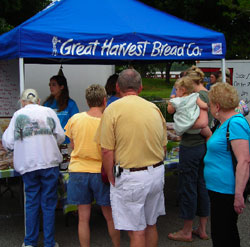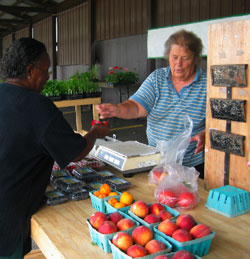With all this recent talk of “going green,” one can’t turn on the television or pick up a newspaper without hearing about the latest in environmental issues and what we can do to help. One suggestion, which not only helps the environment but also the local economy, is adapting your diet to become a “locavore.”
In 2005, four women from the San Francisco Bay area put out the “Eat Local Challenge”: to only eat food grown within a 100-mile radius of your home for one month. Thus, the locavore website (www.locavores.com) was born, offering tips on how to eat locally and the benefits of the locavore lifestyle. According to Time magazine, food on the shelves of U.S. supermarkets travels an average of 1,500 miles from the field to the plate. As gas prices increase and supplies of this nonrenewable resource decrease, the cross-country trek is harsh, both on our natural resources and our pocketbooks. Consumers are then paying for this journey rather than the quality of their foods.
By becoming a locavore, you also help yourself. The longer distance that food travels, the more nutrients are depleted, requiring more preservatives to help them survive the journey. In contrast, most food produced and sold locally has been harvested within 24 hours of being sold, instead of sitting in a truck for days. When farmers sell directly to the general public, there is a better chance for more varieties and specialty produce than when they sell to larger markets. Plus, fresh produce just tastes better.
 In the Midwest, we may not have newly picked citrus fruit or fresh seafood from a nearby ocean, but there are many opportunities to become a locavore in the heart of the country’s bread basket. Local farmers’ markets are one convenient source of fresh produce, and this year will be an exciting one for farmers’ markets in the Peoria area. One of the highlights of summers in the River City is the Peoria RiverFront market, which takes place every Saturday from 8 a.m. to noon. In addition to the goods of area farmers, the market also features local artists and music.
In the Midwest, we may not have newly picked citrus fruit or fresh seafood from a nearby ocean, but there are many opportunities to become a locavore in the heart of the country’s bread basket. Local farmers’ markets are one convenient source of fresh produce, and this year will be an exciting one for farmers’ markets in the Peoria area. One of the highlights of summers in the River City is the Peoria RiverFront market, which takes place every Saturday from 8 a.m. to noon. In addition to the goods of area farmers, the market also features local artists and music.
To celebrate its 30th anniversary this year, the farmers’ market at Peoria’s Metro Centre will receive a fresh coat of red paint and a new logo to help with marketing and promotion. Featuring 15-20 of the area’s local farmers and growers, it is one of Peoria’s oldest farmers’ markets. On June 6, the newest addition to the area’s farmers’ markets opened at the Shoppes at Grand Prairie for its first season. Every Wednesday, customers will be able to purchase produce from 18-20 local farmers from 4-8 p.m., allowing people to stop on their way home from work. Each of these local markets helps to support local farmers and guarantees that your produce was grown locally, ensuring the highest degree of quality and freshness.
One way to spend a fun afternoon and support the local economy is to take a trip to Tanners Orchard in Speer, which officially opens on July 16. This year, Tanners will celebrate 60 years of family activities and delicious produce. Bring the family and spend the day in the orchard, picking from the numerous types of apples grown there. Visitors can have lunch in the Apple Bin Bakery and choose from homemade apple pastries—such as Tanners’ famous apple cider donuts or caramel apple pie. More than just an orchard, Tanners also offers activities such as a corn maze and wagon rides in September and October. It is open from 8 a.m.–5 p.m. Monday through Saturday during July and August, with extended hours in the fall.
At Christ Orchard in Elmwood, visitors can pick their own apples, cherries, plums, pumpkins and squash, and can purchase homemade jam, jelly, honey, cider and Indian corn. You can pick your own strawberries at Terry’s Berries in Elmwood or Austin’s Strawberries and Red Raspberries in Tremont.
 The locavore lifestyle can also be applied to the meat you munch. With Thanksgiving not too far around the corner, you may want to think about feasting this holiday with a locally grown bird at the center of it all. Yordy Turkey Farms, located at 2000 S. Main in Morton, has been raising fresh turkeys for over 70 years. The turkeys are only fed grain that is grown on the farm and are considered 100 percent natural—no antibiotics or growth enhancers are used. Yordy turkeys come flash frozen, with handling and cooking instructions.
The locavore lifestyle can also be applied to the meat you munch. With Thanksgiving not too far around the corner, you may want to think about feasting this holiday with a locally grown bird at the center of it all. Yordy Turkey Farms, located at 2000 S. Main in Morton, has been raising fresh turkeys for over 70 years. The turkeys are only fed grain that is grown on the farm and are considered 100 percent natural—no antibiotics or growth enhancers are used. Yordy turkeys come flash frozen, with handling and cooking instructions.
Critics of the locavore lifestyle claim that people may be depriving themselves of some foods and nutrients not available near them. If you cannot find foods produced locally, organic foods are a suitable alternative, or if not organic, at least from a locally owned store, which still keeps most of the revenue in the area.
Many people who have adopted the locavore lifestyle make a few exceptions for foods that can’t be grown locally, or even in the country, such as coffee beans or chocolate. For those who cannot live without these treats, locavores have deemed “fair trade” brands of these products an acceptable alternative. The fair trade label certifies that workers have received a fair wage and treatment during harvesting and production.
One of the biggest tips offered by veteran locavores is to start small. You don’t have to forego every food not produced locally. Start off by choosing one food group of which to be conscious, buying only local fruits or vegetables, for example. Another suggestion is to choose one day of the week to eat only locally grown foods. Once you have conquered a small sector of the locavore lifestyle, you will be more apt to notice local brands or know the locations which cater to homegrown products. For more information, visit www.locavores.com. a&s


